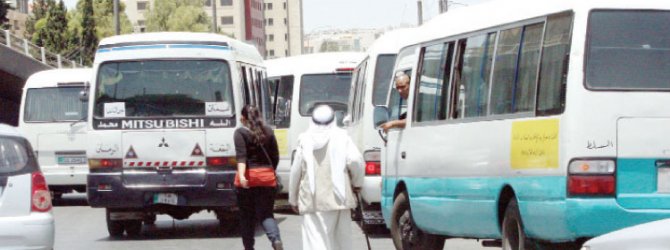-
How Women are Overburdened by Jordan’s Public Transit System
How Women are Overburdened by Jordan’s Public Transit System

The issue of public transport poses a unique challenge to Jordanian women, whose day-to-day activities - and the means by which they get to them - are difficult to anticipate. While men are, in general, able to enjoy the stability of a predictable schedule, for women the issue becomes a little more complicated. Owing to the variety of roles they are expected to play in Jordanian society, as homemakers, caregivers, and perennial jugglers of the material and psychological needs of their families, their routes and destinations differ on any given day - from the baker to the caretaker. As a result, women often try to find employment much closer to home, preferring the trade-off of working fewer hours in exchange for the flexibility it gives them to see to their other tasks. Men, unhindered by such concerns, are able to travel farther afield, accepting opportunities and work schedules which are often deemed unviable for their female counterparts.
A policy brief produced on the topic of women and public transportation by the social justice team at the West Asia-North Africa Institute (WANA) revealed cases of women refusing work opportunities, and even a general decline in female participation in the job market, owing to the inability of public transportation in Jordan to meet their needs. While these women are theoretically afforded the right to work - to be productive, active members of society - the everyday aggravation of navigating the public transportation system is such that these rights are effectively surrendered so as to fulfil the other, more domestic duties that are expected of them.
According to the Jordan Strategy Forum, women make up just 16% of the national workforce - one of the lowest figures globally. The economy, existing legislation, policy, society, culture - all have played a role in the development of this trend, as has the transportation system - whether it is the general quality of the service or the problems women face while using it.
The declining quality of this transportation system presents a real hurdle in the context of women’s increased participation in Jordan’s workforce. The rising trend of these modes of transport being owned by individuals - meaning that individual vehicles are often owned by e.g. the person driving them - is considered the primary reason for this decline. These individuals, ungoverned by the strict rules and policies typically found in larger companies, have created a service subject to individual operators’ own whims and fancies: now in competition with each other, stops are often subject to change, as is the time at which they arrive, and as is the cost of getting there in the first place.
Another contributing factor to the problem is that the administration of public transport, especially in the governorates outside Amman, are made in the capital - made, in other words, out of the hands of those most knowledgeable about the specific needs of each locality. Local governments, themselves representing the various municipalities that make up the governorate as a whole, were until now unable to effectively participate in the administration of their respective public transport systems. The restriction on the mandates of local governments meant that they were unable to set routes, prices, or effectively regulate operator licenses. Without the requisite expertise of local issues and the means by which they may be addressed, the functioning of public transport, and especially the specific interests of the women using them, have fallen by the wayside.
As such, these policies fail to take into account how each gender might use public transport differently, in terms of the reasons mentioned above and even a reluctance to broach the differences between them when formulating and drafting policy. This will not change without the force of a strong, organised political will, as well as the usage of clear, scientific evidence in formulating a solution.
Work to improve public transport in Jordan must include a reassessment of its ownership structure. A movement away, in other words, from ownership by the individual to ownership in a consolidated, company format, pursuant to section 13 of the Regulatory Law for Transportation (2017) which stipulates the obligation of all workers, driving on transit routes and holding an individual license, to integrate either into one company or to actively participate in the administration of a route or routes in a given area. Broadening the means by which local administrations might be granted a stronger mandate in organising its own public transport system would allow them to benefit from the license granted by lawmakers in prior law, which allowed municipalities to work alongside the Land Transport Regulatory Commission by assuming wider powers, such as setting routes, adjusting services to meet demand in a timely and appropriate manner, as well as the granting of operator licenses.
In order to guarantee that the changes made to the public transport system address the needs of women, they - especially those from local communities - must be included in the drafting of new transportation policies. This would ensure that the hurdles and challenges they face would come to an end, as well give them the opportunity to offer solutions based on their own experiences. In conclusion, the emplacement of realistic, effective, and long-term policies aimed at bettering the public transit system in Jordan can only happen one step at a time. But this would broaden the scope of the decision-making process to all of Jordan’s governorates, rather than just the capital. The needs of all - men, women, those with disabilities - would, and should, be taken into consideration.
Translated from Arabic by James Felix Winder

